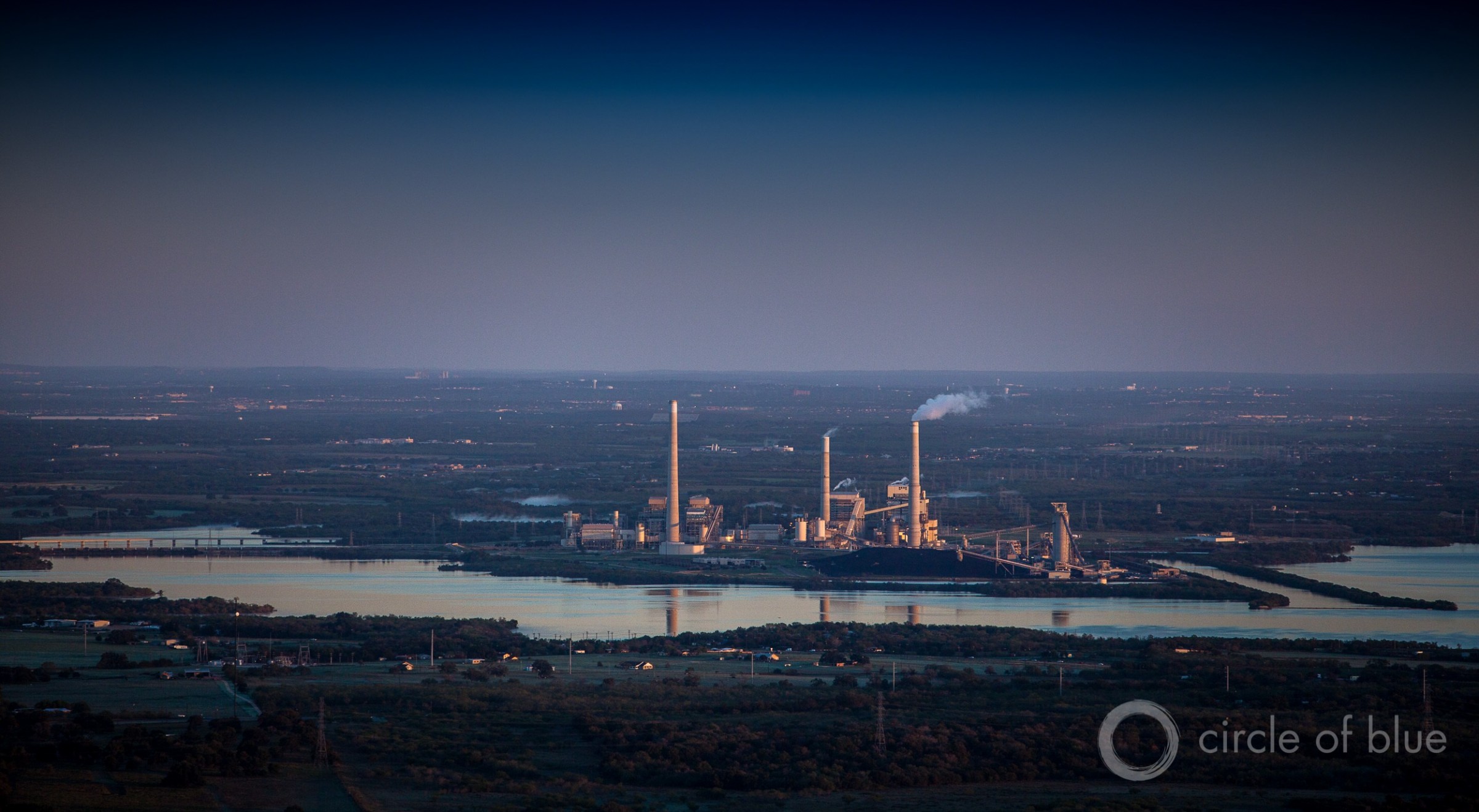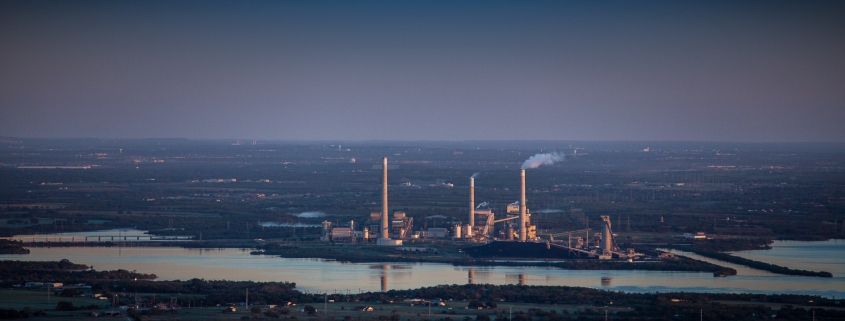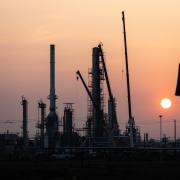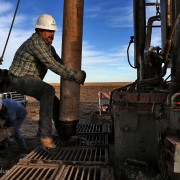Despite Billions in Losses and Clear Financial Dangers, Companies Slow to Respond to Water Risks
More businesses track water use, but fewer take the next step of setting targets.

Because they often rely on water for cooling, power plants can be severely affected by water shortages. Power companies performed better than any sector on setting water withdrawal targets, according to CDP. Photo © J. Carl Ganter/Circle of Blue
By Brett Walton, Circle of Blue
The world’s largest companies, despite increasing awareness of how water scarcity can hurt the bottom line, are not moving quickly enough to address water risks that could harm their reputations, cut growth, and reduce or destroy the value of their assets.
That is the main conclusion of an annual water report from CDP, an organization that works with businesses and investors to address environmental risks.
Companies that responded to CDP’s survey reported $38.5 billion in water-related businesses losses in 2018. Tepco, the Japanese electric utility, and Vale, a Brazilian mining giant, accounted for three-quarters of the losses, both stemming from previous disasters: the Fukushima nuclear meltdown in 2011 and the collapse of a tailings dam at the Samarco iron ore mine in 2015.
Corporate action is not reaching the pace and scale needed to truly address water insecurity.” — Paul Simpson, CDP
With the cycle of drought and flood intensifying because of climate change, incremental fixes won’t cut it, the report argues.
“Corporate action is not reaching the pace and scale needed to truly address water insecurity,” according to Paul Simpson, chief executive officer of CDP.
Retail scored the worst out of 11 sectors for transparency, which means submitting data to CDP and monitoring water use. Retailers were also one of the worst at assessing risks, setting targets, and integrating water into long-term plans.
These omissions are unfortunate, said Cate Lamb, CDP director of water security. The retail sector has leverage in its direct connection to consumers and producers. Grocery stores and clothing companies sell the food and fiber produced by an agricultural sector that accounts for 70 percent of global water withdrawals.
The most conscientious companies are also those taking the most action — at least on paper. CDP looked at a subset of 296 companies that submitted data annually since 2015. They reported an increase in the number of water risks their facilities are exposed to. More encouragingly, the number of companies in this group that set water-use targets doubled.
Targets, however, did not always translate into business practices. The number of companies that reported an increase in water withdrawals between 2015 and 2018 rose by 50 percent. The sectors most affected were food and beverage, manufacturing, and minerals.
The trend of increased withdrawals raises a fundamental question for industries, said Jason Morrison, head of the CEO Water Mandate, a United Nations initiative that works with businesses on water stewardship.
“Are we doing enough?” Morrison asks. “Is our ambition high enough? It’s one thing to achieve some efficiency improvement, but if these companies are growing and absolute water use is going up, are we going to narrow that projected gap between long-term demand and supply?”
Companies explain that the rise comes from increased production. And that might be fine, according to Lamb. Not all regions are water-stressed. But, she says, it sets a worrying example.
“It is disappointing not to see even a modest decrease in withdrawals,” Lamb told Circle of Blue.
What’s missing is high-level leadership, Lamb said. Less than a third of businesses have financial incentives for top executives to reduce water use, and half again as many (15 percent) have incentives to cut pollution. One company that does is Symrise AG, a German chemicals firm. It links 10 percent of its bonus pay for the chief executive and chief financial officers to achieving water, wastewater, and other sustainability targets.
“How is the business going to grow? Where is it going to grow? How will it fuel that growth — with what raw materials? Those decisions can’t be taken at the factory level,” Lamb explained.
Morrison told Circle of Blue that attention at the executive level and within the board of directors is essential for bringing water into a company’s long-term view, moving it from an operational decision, like installing a water-saving boiler, to a strategic judgment that influences company investments and supply chains.
“The misconception around water is that it’s a low-cost input and needs to be managed through operational efficiency,” Morrison said.
Obstacles for Action
Pollution, in general, was a low priority for executives. That is due in part to a lack of internal incentives such as links to bonus pay. But it’s also a result of weak government oversight. Companies, in many cases, do not fear penalties that amount to wrist slaps, Lamb said.
“The regulatory landscape around water quality is such that pollution is not perceived as a material worry to many companies,” Lamb said. “The fines are so small as to not be a concern.”
CDP’s water risk program has grown substantially since it was established in 2010, both in the number of companies that report data and the number of investors requesting that information. A record 2,114 companies responded to the CDP data request last year, up from 175 in 2010.
The highest response rates were from biotech, health care, pharmaceuticals (62 percent), manufacturing (61 percent), and food, beverage, and agriculture (58 percent). The lowest response rates were from fossil fuels (31 percent) and retail (24 percent).
Morrison also sees a broadening engagement with water risk. More and more companies, most recently the Italian energy firm Eni, are committing to the water stewardship principles outlined by the CEO Water Mandate.
Where water is scarce, awareness is heightened. Business executives in Egypt, Iran, Namibia, and Pakistan told the World Economic Forum last year that water availability and pollution are the biggest risks to their operations. In 15 other countries, mostly in southern Africa, southern Asia, and the Middle East, executives named water a top-five risk.
At the same time, companies that want to act come up against two substantial hurdles, Morrison said.
At the operational level, because the price of water is artificially low, investments in water-saving equipment or practices may not pencil out in a cost-benefit analysis that looks only at dollars and cents. And within a river basin, where management authority may be divided between several agencies and jurisdictions, companies often struggle to assess risk and develop long-term strategies among tangled politics and climate uncertainty.
“Whether you’re looking at the operational side of this or the risk mitigation side of this, taking meaningful action has some significant barriers,” Morrison said. “I think that’s where we are right now with the state of play for water and business.”
Brett writes about agriculture, energy, infrastructure, and the politics and economics of water in the United States. He also writes the Federal Water Tap, Circle of Blue’s weekly digest of U.S. government water news. He is the winner of two Society of Environmental Journalists reporting awards, one of the top honors in American environmental journalism: first place for explanatory reporting for a series on septic system pollution in the United States(2016) and third place for beat reporting in a small market (2014). He received the Sierra Club’s Distinguished Service Award in 2018. Brett lives in Seattle, where he hikes the mountains and bakes pies. Contact Brett Walton












Leave a Reply
Want to join the discussion?Feel free to contribute!